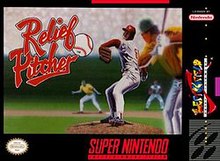
Softball is a game similar to baseball played with a larger ball on a smaller field, with only underhand pitches permitted. Softball is played competitively at club levels, the college level, and the professional level. The game was first created in 1887 in Chicago by George Hancock.
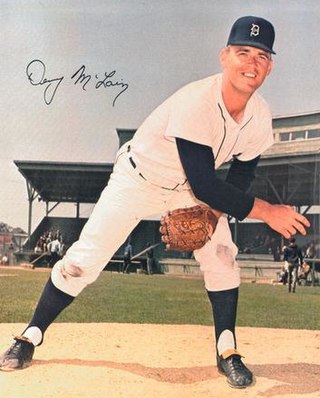
In baseball and softball, a win–loss record is a statistic that indicates the number of wins and losses credited to a pitcher. For example, a 20–10 win–loss record would represent 20 wins and 10 losses.

In baseball, the pitcher is the player who throws ("pitches") the baseball from the pitcher's mound toward the catcher to begin each play, with the goal of retiring a batter, who attempts to either make contact with the pitched ball or draw a walk. In the numbering system used to record defensive plays, the pitcher is assigned the number 1. The pitcher is often considered the most important player on the defensive side of the game, and as such is situated at the right end of the defensive spectrum. There are many different types of pitchers, such as the starting pitcher, relief pitcher, middle reliever, lefty specialist, setup man, and the closer.

Baseball Stars is a baseball video game developed by SNK. It was released for the NES in 1989. It became a major hit in many countries worldwide, particularly in the United States, Canada, and Puerto Rico.

In baseball and softball, a relief pitcher or reliever is a pitcher who pitches in the game after the starting pitcher has been removed because of fatigue, ineffectiveness, injury, or ejection, or for other strategic reasons, such as inclement weather delays or pinch hitter substitutions. Relief pitchers are further divided informally into various roles, such as closers, setup men, middle relief pitchers, left/right-handed specialists, and long relievers. Whereas starting pitchers usually throw so many pitches in a single game that they must rest several days before pitching in another, relief pitchers are expected to be more flexible and typically pitch in more games with a shorter time period between pitching appearances but with fewer innings pitched per appearance. A team's staff of relievers is normally referred to metonymically as a team's bullpen, which refers to the area where the relievers sit during games, and where they warm-up prior to entering the game.

Throughout the history of baseball the rules have frequently changed as the game has continued to evolve. The rules of baseball can vary slightly from league to league, with there being dozens of leagues worldwide. A few common rules most professional leagues have in common is that 4 balls is a Base on balls, 3 strikes is a strikeout and 3 outs ends a half inning. One example of differing rules in professional leagues is in Major League Baseball a pitch clock is in place to speed up the pace of the game by forcing pitchers to pitch in a 15-20 second window, where in the Nippon Professional Baseball League no such rule exists.

Bad News Baseball, originally released as Gekitō!! Stadium in Japan, is a baseball game released by Tecmo for the Japanese Family Computer in 1989, and North America in 1990 for the NES. The goal for players is to defeat every other team in the game. Gameplay can continue indefinitely until this occurs.

Champion Baseball is an arcade baseball video game developed by Alpha Denshi and published by Sega in March 1983. It was a sophisticated sports video game for its time, displaying a split-screen format, with the playfield viewed from two camera angles, one from the outfield and another close-up shot of the batter and pitcher, while giving players the option of selecting relief pitchers or pinch hitters and with an umpire looking on attentively to make the game calls. The game also had digitized voices for the umpire, and individual player statistics. A person could play for hours with one token providing they tied scores at the 9th and further innings.

Super Baseball 2020 is a futuristic baseball video game. It was first released in Japan for the Neo Geo in 1991, and then it was later released in North America for the Sega Genesis and Super Nintendo Entertainment System in 1993. The North American Genesis and European Mega Drive versions feature a package illustration by Electronic Arts artist Marc Ericksen.

Baseball Simulator 1.000 is a baseball game released on the NES. It was released in 1989 in Japan and in 1990 in North America.
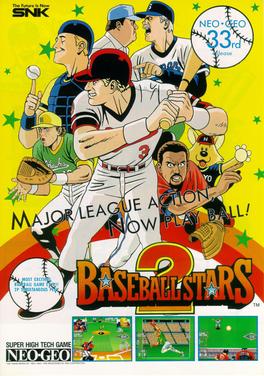
Baseball Stars 2 is a 2-player baseball sports arcade game released by SNK in 1992 for the Neo-Geo console. A less detailed console version was released for the NES by Romstar the same year.

Tommy Lasorda Baseball is a 1989 baseball video game developed and published by Sega as one of the six launch titles for the Sega Genesis in the North America and for the Sega Mega-Tech arcade system. It is a follow-up to the arcade game Super League (1987). It prominently features former MLB player Tommy Lasorda, who was manager of the Los Angeles Dodgers at the time. In the game, players compete with either AI-controlled opponents or against other players across single exhibitions, open matches or a 30-game season.
This is an alphabetical list of selected unofficial and specialized terms, phrases, and other jargon used in baseball, along with their definitions, including illustrative examples for many entries.

Major League Baseball is a sports video game released in 1988 for the Nintendo Entertainment System. It is notable for being one of the first video games licensed by Major League Baseball, although it was not endorsed by the Major League Baseball Players Association. Without the backing of the Players Association, the game could not name the actual players, although it was able to use their numbers, thus accurately portraying the contemporary teams and their rosters. In doing so, it became the first baseball game for the Nintendo Entertainment System to carry official Major League Baseball licensing and lineups.
Front Page Sports Baseball was a series of baseball games created by Dynamix in the mid to late 1990s. It remains popular as a simulation engine for online leagues.
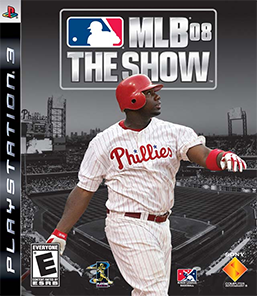
MLB 08: The Show is a baseball simulation video game developed by San Diego Studio published by Sony Computer Entertainment for the PlayStation 2, PlayStation 3, and PlayStation Portable systems. It is the longest-running officially licensed Major League Baseball game series on the PlayStation systems. MLB 08: The Show is the third edition of the MLB: The Show series of video games. The game was announced for all three PlayStation consoles on December 11, 2007, and released on March 4, 2008 in North America. Ryan Howard, all-star first baseman for the Philadelphia Phillies, is featured as the game's cover athlete.
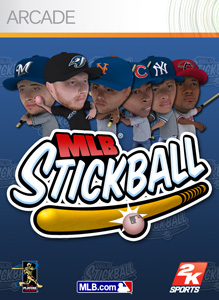
MLB Stickball was a Major League Baseball-licensed stickball video game published by 2K for the Xbox 360 via Xbox Live Arcade. It was released on October 8, 2008, and removed from the Xbox Live Marketplace in December 2014.

In baseball statistics, earned run average (ERA) is the average of earned runs allowed by a pitcher per nine innings pitched. It is determined by dividing the number of earned runs allowed by the number of innings pitched and multiplying by nine. Thus, a lower ERA is better. Runs resulting from passed balls, defensive errors, and runners placed on base at the start of extra innings are recorded as unearned runs and omitted from ERA calculations.

Super Batter Up, known in Japan as Super Famista, is a baseball video game with both a one- and two-player mode plus a league mode.

The Fairchild Channel F is a home video game console released by Fairchild Camera and Instrument in November 1976. It has the distinction of being the first programmable ROM cartridge–based video game console, and the first console to use a microprocessor. It was launched as the Fairchild Video Entertainment System, or Fairchild VES for short, but when Atari released their Atari Video Computer System, Atari VCS, later Atari 2600 the next year, Fairchild renamed its machine.
